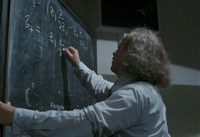Andrey Losev & Maxim Leyenson "QUANTUM PHYSICS WITH AND WITHOUT PLANK CONSTANT"

Andrey Losev & Maxim Leyenson
QUANTUM PHYSICS WITH AND WITHOUT PLANK CONSTANT
(Continuation of the course PHYSICS FOR MATHEMATICIANS AND MATHEMATICS FOR PHYSICISTS
Schedule:2:00 pm-4:00 pm, from Tuesday to Friday, Sept.19-Dec. 29, 2023
Venue:Zoom Meeting ID: 687 513 9542 Passcode: YMSC
Date:2023-09-19~2023-12-29
Please register.
Dear all, we are continuing the zoom course, the aim of this course is to explain modern physics for mathematicians and provide physicists with adequate mathematical tools. This semester as promised would be devoted to Quantum Field Theory. There are two different approaches to Quantum Field Theory. First one was started by Dirac and finally formalized by Segal : space-time is considered as a smooth manifold but physics is new, Quantum field theory is just a symmetric monoidal functor from geometrically equipped cobordisms to linear algebra. There is no Plank constant in Dirac-Segal approach. Second was proposed by Feynman, it basically keeps classical physics, involves Plank constant but … changes geometry of the space-time to something new. Surprisingly, both approach describe the same physics.
We will study it in detail in simplest examples. Our third semester will be about Higher Topological Quantum Theories. Topic of fall semester:
-
Symmetric monoidal categories, linear algebra and cobordisms as examples.
-
One-dimensional cobordisms and Dirac Quantum Mechanics
-
Probabilistic interpretation of Quantum Mechanics and Schrodinger cat paradox
-
Representations of SU(2) and appearance of classical mechanics as the limit
-
Differential operators on superschemes and their classical limit
-
Bosonic and fermionic harmonic oscillators, their partition functions, anharmonic oscillator problem and Feynman diagrams
-
Functional integral in quantum mechanics, free particle, bosonic and fermionic oscillators, alternative computation of partition functions for oscillators, first appearance of infinities
-
Sigma-model quantum mechanics as Laplacians, sigma-model on a circle, comparison of Dirac and Feynman approaches, Poisson formula.
-
Feynman diagrams for anharmonic oscillator from Feynman approach, Schwinger times and Quantum mechanics on graphs.
10.Symmetry in Quantum Mechanics, Supersymmetry and Laplacian on differential forms, superpotentials and Witten-Gerasimov-Barannikov-Kontsevich generalized complex structure
-
Cobordisms equipped with metric and two-dimensional theories
-
Cobordisms from Feynman integrals in free bosonic and fermionic theories
-
Partition function on a torus in free theories
-
Idea of 2-dimensional sigma-model, explicit description of its partition function for target space being a torus.
-
Loop algebras
-
Segal description of free field theories in terms of chiral algebras
-
Segal description of theories governed by Kac-Moody algebra
-
Concept of local observable in Segal approach to OFT, examples
-
Local observables in Feynman approach to QFT, tachions and vortexes
-
Anomalous dimension of local observables in Segal and in Feynman approaches to QFT
-
Operator product expansion in Segal approach, free field theory examples
-
T-duality for sigma-models with target space being a torus from Feynman perspective
-
T-duality from Segal perspective
-
Bosonisation of fermions as another example of duality
-
Gauge anomaly in free fermionic theory
-
Energy-momentum tensor and conformal anomaly
-
Sugawara formula and KZB equations
Mathematics for physicists would support physics for mathematicians program and include:
Complex curves versus Riemann surfaces, moduli of complex structures, line bundles and vector bundles on complex curves, line bundles on moduli spaces of
vector bundles, line bundles on moduli spaces of complex structures, complex and almost complex structures on smooth manifolds, Kodaira-Spencer theory of deformations of complex structures.
Welcome to our program, Andrey Losev and Maxim Leyenson.
https://sites.google.com/site/mleyenson/geometry-page-of-maxim-leyenson/teaching/courses/2023-mathematics-for-physicists-2

